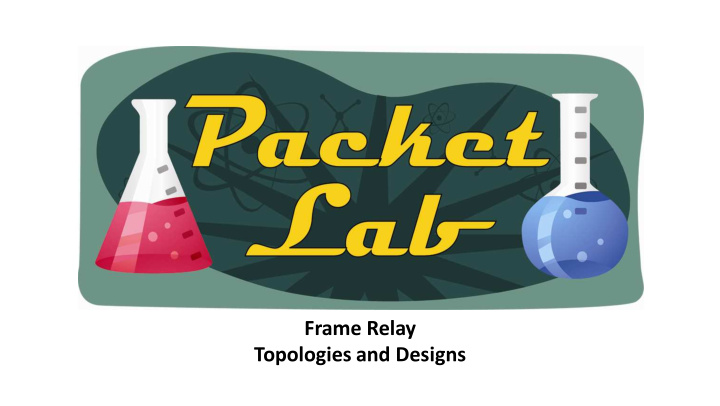



Frame Relay Topologies and Designs
Frame Relay Topologies and Design As we learned in the Frame Relay - Introduction and Concepts lesson, Frame Relay introduces some cost savings benefits over point-to-point leased lines. This lesson will review some of those advantages as well as concentrate on different designs and which of those designs are best suited to take advantage of Frame Relay’s benefits.
Frame Relay Versus Point-to-Point Leased Lines One of the biggest selling points for Frame Relay over point-to- point (sometimes just refered to as ‘leased lines’) WAN connections is that by utilizing Frame Relay Virtual Circuits (VCs) you can save on the number of physical connections purchased. Frame Relay provides this savings via: - Multiple VCs can use the same physical connection to the carrier’s Frame Relay cloud. - Frame Relay Hub-and-Spoke design allows for full connectivity to all endpoints through a single physical connection to the carrier’s Frame Relay cloud. We’ll discuss the Hub -and-Spoke design in more depth, but with this design you can shave the number of physical connections in half compared to a full mesh point-to-point topology.
Full Mesh In a full mesh design, each end point is capable of reaching any other end point directly through a point-to- point physical or logical circuit. The number of connections needed for a full mesh is calculated with the following equation: N(N-1)/2 where N is equal to the number of end points. For example, a network with 3 endpoints requires: 3(3-1)/2 = 3(2)/2 = 6/2 = 3 connections Unfortunately, it’s hard to scale a full mesh design as the number of required connections becomes a financial and management nightmare as your network grows. For instance, the required number of connections needed for a full mesh design with 10 endpoints: 10(10-1)/2 = 10(9)/2 = 90/2 = 45 connections!!!
Full Mesh Pros: - Provides full redundancy Cons: - Expensive (circuit and router costs) - Difficult to design - Difficult to manage - Can result in complicated routing/IP addressing scheme
Full Mesh Full Mesh with 3 End Points Full Mesh with 5 End Points N(N-1)/2 = 3 N(N-1)/2 = 10
Full Mesh While this is not a very common design, you can design a full mesh using Frame Relay. The only advantage that this design would have over a point-to-point leased line implementation is that you can reduce the number of physical connections to the carrier (you could have a single physical connection for each end point) as well as saving on the number or router interfaces. The cost savings would have to be weighed against the single point of failure for each physical connection.
Partial Mesh In a partial mesh design (sometimes called a ‘hybrid’ design ), is basically a full mesh design with at least one less connection between end points. Technically, any design that is not a full mesh can be described as a partial mesh if at least one end point has redundancy to at least one other end point. This design type is far more popular than a full mesh design. You can build redundancy into a partial mesh design, but you can also choose to leave out that redundancy for less important end points. Pros: - Less complex than full mesh - Less expensive than full mesh Cons: - Not fully fault tolerant
Partial Mesh
Hub and Spoke The Hub and Spoke design is the design that many Frame Relay networks use. The Hub and Spoke design is basically a star design utilizing Frame Relay’s advantage of provisioning multiple VCs on a single physical connection (often referred to as the ‘access circuit’). In most designs, the hub router is located at a larger site (corporate headquarters for instance) and the spokes are generally located at less data intensive “remote” sites. Pros: - Economical (less physical connections on routers as well as number of access circuits) - Easy to manage - Easy to scale (adding new spokes is simple to design) - Generally allows you to conserve Layer 3 addressing. - Allows you to provision slower access speeds at the spokes than at hub. Cons: - All traffic between spokes must traverse the hub. - Single point of failure on hub access circuit - Routing between spokes can be prevented by Split Horizon rule. Note: Most hub and spoke designs will add some redundancy between endpoints, making the design technically become a partial mesh design.
Star Topology
Hub and Spoke
Hub and Spoke
Summary One of the main benefits of Frame Relay over point-to-point leased lines is that you can achieve cost savings by reducing equipment and circuit costs. In order to take advantage of these savings, it’s important to know how to incorporate these benefits into your network design. While it’s certainly possible to design a full mesh network using Frame Relay, most Frame Relay designs use (at least as their starting point) a hub and spoke design as this design uses Frame Relay’s advantages. Some of the advantages of a hub and spoke Frame Relay network are the ability to easily scale, reduced cost in the from of less network equipment and less physical connections to the provider, and ease of management. There are a few downsides to a hub and spoke design as well such as a single point of failure on the hub physical access circuit and the need for spoke to spoke traffic to traverse the hub. These issues can be minimized in many instances by modifying the hub and spoke design into a partial mesh design.
Recommend
More recommend